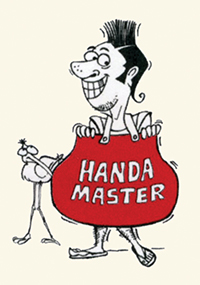Of lahuvaas, haandaas, fituris and kaklaats
Berjis Desai
The genteel, docile proper bawaji is now a rare commodity. There is an increase in the number of lahuvaas, haandaas, fituris, kaklaats and pallonjis. These are highly technical terms which are difficult at times to distinguish even for a seasoned community watcher like your columnist. To illustrate these definitions is flirting with libel, so forgive us the slightly roundabout way of explaining these caricatures who are found both among the Masoor paav Parsis and the NCPA Parsis. And please do not try to categorize your in-laws and increase the number of contested divorces before the Parsi Matrimonial Court.
The easier ones first. A kaklaat is a garrulous, incessant talker of nonsense which is jarring on the nerves. The listener feels physically exhausted after a kaklaat departs. Kaklaats steal your energy. A well versed kaklaat will not let you interrupt his diatribe and he never listens to you. He is usually loud and raucous but there is also the soft speaking, whining variety narrating her sob story. They must not be confused with manjans (tooth powder) who are mechanical repeaters of the same point ["Meher to ékdum Colgate nu nallu packet chhè (Meher is truly a small packet of Colgate tooth powder).”] An authentic kaklaat will create a shindig, a disturbance. In pristine Gujarati, kaklaat means plaintive crying, like a bird distressed at the loss of her young ones from the nest. In Parsi dialect, however, a true kaklaat will make the most peace loving person want to smash a flower pot on his offending head.

Illustration by Farzana Cooper, reprinted with permission from Parsi Bol 2
A pallonji is more than a show-off. A plain vanilla puffer goes by the little known but endearing term of foortaji. A pallonji is a compulsive attention seeker who spins yarns, exaggerates, pretends to be what he is not. If he is at Allbless Baug, he wants to be the bridegroom and if he is at Doongerwadi he wants to be the corpse. At community functions, he will be found sitting in the front row, turning around all the time to ensure he is being noticed. His morbid fear is that he will be ignored. A serial ‘vote of thanks’ giver, he is quick to garland or wrap a shawl around the chief guest. Irrespective of his ability, he volunteers to take the lead in any initiative or movement or crusade. A publicity hound, he wants his mugshot published everywhere. In our days as a journalist, one such pallonji, who was once upon a time a minor minister, would insist every other day that his picture accompanies every silly press release he issued as chairman of some state board. Irritated with his constant requests, we published his photo next to the obituary column which greatly offended him and he protested to the editor. Next time, we sandwiched his visage between two news reports of criminal fraud. He never again called the newspaper. We had also encountered a female pallonji whose every picture appeared identical, with the same exaggerated tilted head, a pasted mile long smile, and a garland in her podgy hands. If a pallonji is wealthy, he loves to flaunt his wealth. Pallonjis are not usually evil but mostly odious.
Kaklaats, manjans and pallonjis are benign but fituris can cause a lot of stress. They are the touch-me-nots. Itching for a fight, their lungs yearn for a shouting match. Quick to take offence, they love brawls and fisticuffs. They endeavor to provoke and are most disappointed when they meet some thanda pani nu matloo (a calm person) who refuses to bite their bait and lock horns. Fituris are in full form at Bombay Parsi Punchayet elections and in Court corridors during hotly contested community litigations. They feel cheated out of a slanging match if their opponent refuses to engage in some old-fashioned maramari (fights) and garagari (exchange of cuss words). Fituris are cantankerous, crotchety, hyperactive Parsis. Freud would have classified their high agitation as a substitute for sex.
The nuance between a haandaa and a lahuvaa is rather subtle. The latter engages in loutish behavior like interrupting a Adi Marzban masterpiece called Asha Nirasha (hope and despair) on Parsi New Year’s Day by shouting, "Ardeshir, saré saparmé dahaaré humé rarva nathi aaya (we have not paid to cry on an auspicious day).” The haandaa in the audience, while wholeheartedly agreeing with the lahuvaa’s views, may not necessarily approve of such loutish behavior in public. Haandaas love the gross and the crass and enjoy the discomfiture of the prigs. Once at a Yehudi Menuhin concert in Bombay, when the great violinist was playing Violin Sonata No 5 in F Major, with his talented sister, Hephzibah, before a largely Parsi audience, the latter’s microphone (those were not the days of sophisticated acoustics) emitted a sound like someone breaking wind. One lahuvaa, to the great consternation of the very proper Parsis, loudly remarked that Hephzibah must have eaten too much dhansak. The haandaas at the concert, terribly bored with the slow movement, must have been secretly thrilled with the lahuvaa’s interjection.
If you ever come across a haanda at heart, who is also a loud lahuvaa, and has the mannerisms of a pallonji, can sound like a kaklaat and create a fitur, do let us know, so that we can recommend him to fill any vacancy that may arise in one august community institution.
Berjis M. Desai, is a lawyer in private practice and a part-time writer. He considers himself an unsuccessful community activist.
